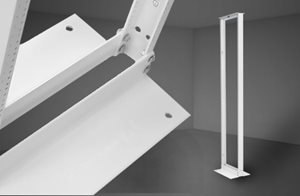Practical Ways to Ensure Proven Results When Selecting Open Frame Server Racks
December 19, 2022
When it comes to organizing and setting up equipment in a computer room or data center, it is important to make the best use of the space available. For this reason, open frame server racks remain an ideal solution to help stay organized in a cost-effective manner. Rack systems also provide:
- A viable solution for many data center deployments, and address a variety of applications, from supporting active equipment, to providing a straightforward cable patching platform.
- Straightforward access to the equipment or cabling sections—without walls or side panels, the hardware is accessible from all angles, even after the installation of the cabling and active equipment.
- Unrestricted airflow to equipment.
- Easy access, which can reduce maintenance time and costs of future changes.
- Strong support, with load ratings up to 1500 lb (680.4 kg) for two-post racks, and up to 2200 lb (1000 kg) for four-post racks.
In essence, open frame racks are cost effective, easily accessible and durable, which makes them a smart option for telecom equipment, servers or networking with a relative low power load where cooling requirements are not a key cause for concern.
With those benefits in mind, once you’ve determined if a rack system makes the most sense for your application, it’s time to make the right selection. Strength, stability and durability are all key factors, as is the ability to keep equipment safe and secure.
Two-Post or Four-Post?
 Delineating between the two options is fairly straightforward. Two-post racks are typically used with open, floor-mount racks for patch panels and fiber enclosures with rack-mount equipment that is less than 20”D (510 mm), while four-post racks are a smarter choice for larger and heavier equipment, like network switches, because they surround equipment and provide front and rear support. Making the right selection usually depends on your current and future equipment needs.
Delineating between the two options is fairly straightforward. Two-post racks are typically used with open, floor-mount racks for patch panels and fiber enclosures with rack-mount equipment that is less than 20”D (510 mm), while four-post racks are a smarter choice for larger and heavier equipment, like network switches, because they surround equipment and provide front and rear support. Making the right selection usually depends on your current and future equipment needs.
What to Plan For
Regardless of which option best suits your application needs (two- or four-post), be sure to keep in mind that rack-mount width must match equipment requirements. The depth of the rack, especially a four-post rack, must be carefully selected.
Generally, you should plan a minimum 3’ (0.9 m) aisle at the front and rear of the rack. The height of the rack also determines the number of rack-mount unit (U) spaces on the rack. Additionally, racks that feature marked and numbered rack-mount spaces can greatly assist in determining remaining space available for future moves, adds and/or changes.
It is also important to pick a height that provides enough overhead space for cable runway or cable trays. Note the relationship of rack height to ceiling height in the graphic above. Always leave 3” to 6” (80 mm to 150 mm) of space between the top of racks and cable runway. Leave 12” (300 mm) between each tier of cable runway and 18” (460 mm) between the ceiling and the top tier of cable runway.
With these tips in mind, be sure to review Chatsworth Products’ (CPI) Quick Reference Guide for Rack Systems. In an easy-to-scroll chart, you’ll find everything you need to find the right rack to suit your specific application needs, and the accessories to match.
Posted by Jeff Cihocki, Content Manager at 12/19/2022 8:51:16 AM